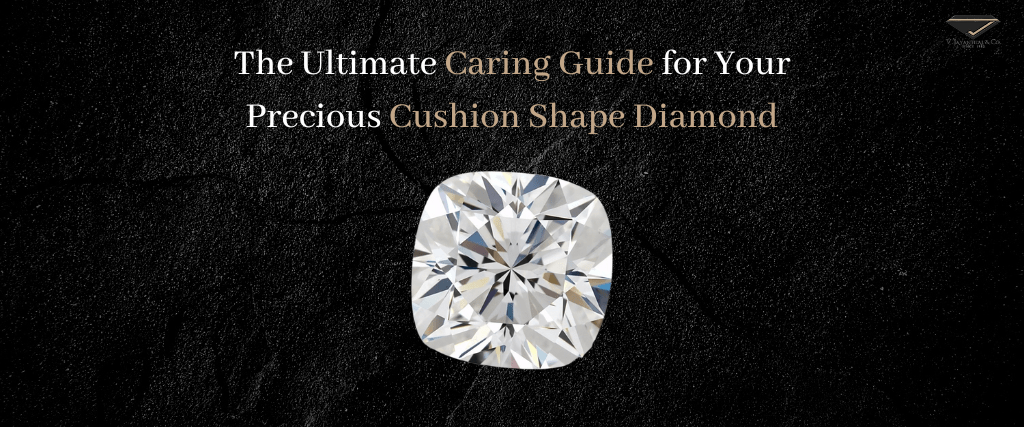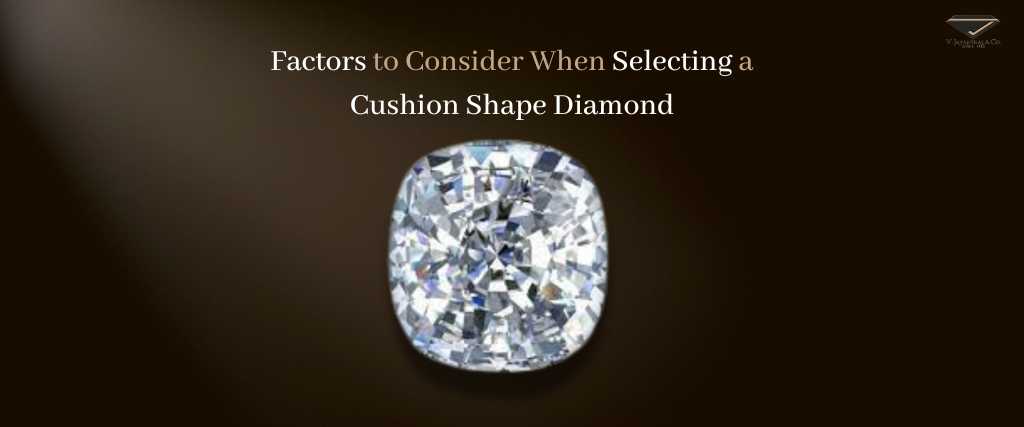
Cushion-cut diamonds are renowned for their timeless elegance and captivating sparkle, making them a popular choice for engagement rings and fine jewellery. To ensure that your cushion-cut diamond continues to shine brilliantly, it's essential to provide it with the proper care and attention. In the following care tips, we will explore in detail the various facets of cushion shape diamond care, from regular cleaning and professional inspections to safeguarding against potential damage and preserving the structural integrity of these stunning gems. By following these guidelines, you can enjoy the enduring beauty and radiance of your cushion-cut diamond for many years to come.
Also Read: Buy Cushion Cut Diamond Engagement Rings
Certainly, here's a more detailed guide on caring for a cushion-cut diamond:
To clean your cushion-cut diamond, create a mild soapy solution by mixing a few drops of dishwashing soap in a bowl of warm water. Soak the diamond in this solution for about 20-30 minutes.
Gently scrub the diamond with a soft toothbrush, paying attention to the areas behind the stone where dirt can accumulate. Be gentle to avoid scratching the metal or the stone itself.
Rinse the diamond under warm, running water to remove any soap residue. Make sure the drain is closed or use a plug to avoid any accidental loss.
You can use an ultrasonic jewellery cleaner, but be cautious. Most cushion-cut diamonds can handle ultrasonic cleaning, but some may have structural vulnerabilities. Consult your jeweller to ensure it's safe for your specific diamond.
Some jewellers use steam cleaning machines, which can effectively remove dirt and grime. Again, consult with your jeweller to determine if this is suitable for your particular diamond.
Avoid exposing your diamond to harsh chemicals like chlorine or bleach. These chemicals can corrode or damage the metal setting, which can impact the diamond's setting and brilliance.
When not wearing your cushion-cut diamond jewellery, store it separately from other pieces to avoid scratches and damage. Use a jewellery box with individual compartments or a soft, lint-free pouch.
Have your diamond professionally inspected by a reputable jeweller at least once a year. They can check the setting, prongs, and overall condition of the diamond to ensure it's secure and in good shape.
Regularly inspect the prongs holding your cushion-cut diamond. If you notice any prongs are loose or worn down, have them repaired by a professional jeweller to prevent the diamond from falling out.
Cushion-cut diamonds, with their rounded corners, can be more susceptible to chipping or damage from impacts. Be cautious when wearing your jewellery to prevent accidents.
Cushion-cut diamonds are typically sturdy, but high heat can affect the integrity of some types of diamonds or the metal setting. Avoid exposing your diamond to open flames or extreme heat.
If you need to resize your ring, consult a professional jeweller with experience in working with cushion-cut diamonds. Resizing should be done with care to avoid damaging the stone or the setting.
Consider insuring your cushion-cut diamond jewellery, especially if it's valuable. This will provide financial protection in case of loss, theft, or damage.
Ensure your cushion-cut diamond comes with a certification from a reputable grading laboratory. This document provides important details about the diamond's quality and characteristics.
Be mindful of how and when you wear your diamond jewellery. Remove it when participating in activities that could subject it to unnecessary wear and tear.
By following these detailed guidelines, you can ensure that your cushion-cut diamond remains in beautiful condition and retains its brilliance for years to come. It's always a good idea to consult with a professional jeweller for specific advice and maintenance needs related to your diamond piece.
Certainly, let's explore each type of cushion-cut diamond in more detail:
The standard cushion cut is characterized by a square or rectangular shape with rounded corners, resembling a pillow. It typically has larger facets and offers a balanced combination of brilliance and fire. This classic cut is known for its timeless and elegant appearance.
Care tips: Care for it as described in the previous care guide.
Antique cushion cuts are inspired by vintage and antique jewellery styles from the 19th and early 20th centuries. These diamonds often have larger facets, a more pronounced culet (the bottom facet), and a unique charm that evokes the romanticism of a bygone era. They exhibit a warm and understated brilliance.
Care tips: Clean and care for antique cushion-cut diamonds as you would for standard cushion cuts.
Modified cushion cuts introduce slight alterations to the standard cushion cut. These alterations can include variations in the number of facets, additional facets, or different facet arrangements. The result is a unique play of light and sparkle, making each diamond special and distinct.
Care tips: These diamonds may require more careful cleaning due to their intricate facet arrangements. Use a soft brush to clean them gently.
The crushed ice cushion cut is characterized by numerous small facets that create a shimmering, "crushed ice" effect. It offers a more modern and unique appearance, with a dazzling, scintillating quality. Due to the intricate facet pattern, these diamonds require careful cleaning to maintain their brilliance.
Care tips: Clean these diamonds with extra care, as the many facets can trap dirt more easily. Use a soft brush to clean between the facets and ensure thorough rinsing.
Brilliant cushion cuts are designed to maximize sparkle and radiance. They feature a higher number of smaller facets, enhancing the play of light. These diamonds exhibit a vibrant and lively appearance, making them an excellent choice for those who love a more contemporary, brilliant look.
Care tips: Clean them as you would standard cushion cuts but pay attention to their intricate facet patterns.
Cushion-cut diamonds are available in a range of fancy colours, including yellow, pink, blue, and more. Their defining characteristic is their colour, which can range from subtle pastels to deep, vivid hues. Caring for fancy-coloured cushion cuts involves protecting their colour from fading due to prolonged exposure to sunlight.
Care tips: Regularly clean and inspect the setting, as vibrant colours tend to draw more attention to imperfections.
The double halo cushion cut features a central cushion-shaped diamond surrounded by two concentric halos of smaller diamonds. This style adds extra sparkle and a dramatic, glamorous effect to the diamond, making it a statement piece. Cleaning should involve ensuring that both the centre stone and surrounding stones remain clean and secure.
Care tips: Clean the double halo cushion-cut diamond regularly to prevent dirt and oils from dulling its sparkle. Soak it in warm, soapy water and use a soft brush to gently clean the diamond and the surrounding smaller stones. Rinse under warm, running water to remove any soap residue, and pat dry with a soft, lint-free cloth.
In a split shank cushion cut, the band of the ring is split into two or more strands, creating a unique, elegant, and modern design. Prong maintenance is particularly important for these rings to ensure the diamond remains secure, given the exposed nature of the stone.
Each type of cushion-cut diamond has its unique charm, and your choice depends on personal style and preferences. Caring for these diamonds involves specific considerations based on their characteristics, so it's essential to understand the type of cushion-cut diamond you own and maintain it accordingly.
A cushion shape diamond care chart can help you maintain the beauty and brilliance of your diamond. Here's a chart summarizing cushion-shape diamond maintenance tips:
| Care Aspect | Care Tips for Cushion Diamonds |
| Cleaning | - 1) Soak in warm soapy water and gently scrub with a soft toothbrush. |
| Cleaning | - 2) Rinse under warm, running water to remove soap residue. |
| Cleaning Frequency | - Clean at least once a month to prevent the buildup of dirt and oils. |
| Ultrasonic Cleaning | - Generally safe, but consult a jeweller if unsure. |
| Steam Cleaning | - Consult a jeweller for suitability for your specific diamond. |
| Chemical Exposure | - Avoid exposure to harsh chemicals, like chlorine or bleach. |
| Storage | - Store in a separate compartment of a jewellery box or a pouch. |
| Professional Inspection | - Have your diamond checked by a jeweller yearly. |
| Prong Maintenance | - Regularly inspect prongs; repair if loose or worn down. |
| Avoid Impact | - Cushion cuts may be vulnerable to chipping; be cautious. |
| Heat Exposure | - Avoid extreme heat, open flames, or prolonged sunlight exposure. |
| Resizing | - Consult an experienced jeweller for resizing. |
| Insurance | - Consider insuring your diamond for protection against loss. |
| Certification | - Ensure you have proper certification for quality verification. |
| Fancy Colors | - Protect fancy-coloured cushion diamonds from prolonged sunlight. |
| Professional Cleaning | - Periodically have a jeweller professionally clean and inspect it. |
Also Read: Factors to Consider When Selecting a Cushion Shape Diamond
In conclusion, caring for your cushion-cut diamond is an essential aspect of maintaining its enduring beauty and brilliance. Regular cleaning, professional inspections, and vigilant attention to prongs and settings are vital components of diamond care. By following these guidelines, you can ensure that your cherished cushion-cut diamond from V. Jayantilal & Co. remains a symbol of timeless elegance and continues to captivate for generations to come. Thank you for entrusting us with your precious gems, and we look forward to being a part of your jewellery's legacy.

The cushion cut is among the ten most popular diamond shapes and is a favourite among modern brides and celebrities. The earliest diamond cut, known as the old mine cut, gave rise to the timeless, opulent diamond shape known as the cushion cut.
This combination of old and new makes it vintage yet modern and desirable as an engagement ring for many women. It’s famously known to have a soft pillow-like shape, which is where the name cushion was born.
So, if you are thinking about buying a cushion-cut diamond, you have come to the right place. You will learn in this article what to look for when selecting a stunning cushion-cut diamond that sparkles and shines.
Let's dive in...
The cushion cut combines the elegance of a square-cut diamond with the ethereal beauty of a round diamond, yet there isn't really a grading system for these gems. Its rounded corners and soft square form give it the appearance of a cushion.
The cushion cut has been around for more than 200 years, despite the fact that it may be one of the most well-liked diamond shapes today. However, it was more commonly referred to as a "mine cut" in the 19th century. previous mine-cut diamonds had 58 facets, while more recent ones had 64. This is the primary distinction between previous mine-cut diamonds and today's diamonds.
The choice of round-cut versus cushion-cut might affect your purchase because of their considerable differences.
Known as the “miner cut” or “chunky cushion,” the old mine cut antique cushion was the main shape of the Victorian and Edwardian eras. What’s unique about it is that it’s rare and has many different looks. The old mine-cut antique cushion is characterized by its large, open culet and high crown, giving it a distinctive chunky appearance. Its facets are usually larger and fewer in number compared to modern diamond cuts, resulting in a unique play of light and a romantic vintage charm. This cut was popular during the 19th and early 20th centuries, reflecting the design preferences of those eras.
The main distinguishing characteristic of the cushion-modified cut is the additional row of facets. The sight of crushed ice also gives off a sparkling charm. This extra row of facets enhances the cushion-modified cut's brilliance and scintillation, making it a popular choice for those seeking maximum sparkle. Additionally, the crushed ice appearance adds a unique and modern touch to the traditional cushion cut, giving it a contemporary and eye-catching allure.
The brilliant-cut diamond has bigger but fewer facets, making it rarer than the modified cut. It shines more, like a round brilliant cut, though. It typically has an elongated form with a length-to-width ratio of 1.10 to 1.25. The modified brilliant-cut diamond, on the other hand, is more commonly seen due to its versatility and popularity. It is known for its exceptional brilliance and fire, making it a popular choice for engagement rings and other jewellery pieces.
The square cushion cut diamond, as its name suggests, has sides that are all the same length, giving it the appearance of a geometric square. Instead of having sharp corners, this cut features rounded ones. The square cushion cut diamond is known for its ability to combine the elegance of a cushion cut with the modern appeal of a square shape. This unique combination creates a timeless and sophisticated look that is highly sought after in engagement rings and other jewellery pieces.
These diamonds, which are often referred to as rectangular cushion cuts, have an extended form and are mounted vertically. The length is always taller than the width of the diamond. The elongated shape of the cushion-cut diamond gives it a unique and elegant appearance. This shape is particularly popular for engagement rings, as it creates a stunning and sophisticated look on the finger.
Cushion diamonds have a special diamond quality, just like the 4Cs of every fancy-cut diamond. Here are the Carat, Cut, Clarity, and Color of cushion-cut diamonds.
Due to the significance of carat weight, cushion-cut diamond prices might fluctuate. A bigger weight will attract higher price points because larger diamonds are most popular for engagement rings and are more appealing and expensive.
The cut quality of a cushion-cut diamond determines its quality. The many facets on the surface of a cushion-cut diamond give it a brilliant look. A well-cut diamond should have a depth and table of less than 70%, symmetry, and polish of at least very good.
Most VS2 and a small fraction of SI1 cushion-cut diamonds appear eye-clean, with their flaws hidden by the diamond's brilliance and scintillation. Modern cushion-shaped diamonds sparkle due to their well-cut facets. To increase their clarity, inclusions are present in almost all diamonds. The diamond must be thoroughly examined because there will be more inclusions visible in bigger stones. Always aim for the lowest eye-cleansing clarity possible.
Also Read: Understanding the 4C's of Diamond - A Comprehensive Guide
While the cut quality of a diamond is the most crucial component of its attractiveness, the color grade must also be studied properly. Cushion diamonds exhibit more color than round brilliants, although their brilliance and dispersion aid in color concealment.
When choosing a cushion-cut diamond to be put in a white gold engagement ring, stick to a colour grade of H or better. On a tight budget, one can get away with I or even J-colored diamonds and still have a white look.
Cushion cut standards vary more than most other forms, and personal preference will determine the choice. While less brilliant than round brilliant diamonds, cushion-cut diamonds can have more fire, which increases their allure. One of three fundamental pavilion facet designs characterizes modern cushion cutting. The third design features an additional row of facets on the pavilion and is classified as a "Modified" cushion cut by the GIA. These modified cuts have a "crushed ice" or needle-like facet pattern, which is more akin to a radiant cut than a standard cushion cut.
The crushed ice or needle-like facet pattern of the modified cushion cut jewellery gives it a unique and distinctive appearance. This design choice can enhance the diamond's brilliance and create a mesmerizing play of light. Additionally, the modified cushion cut is often favored by those who appreciate a more contemporary and unconventional look in their diamond jewellery.
Now that we’ve covered everything you need to know in depth regarding cushion-cut diamonds in-depth, it is important to know where to purchase a cushion-cut diamond. You will find a cushion cut diamond from V. Jayantilal & Co., Mined and cut with brilliance, diamonds here are most valued for their charm and brilliance.
I hope this article has helped, and if you have any questions or need a second opinion on a diamond, feel free to contact us!

